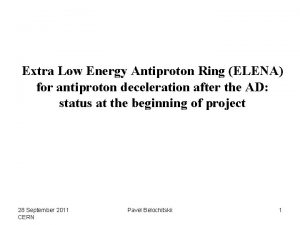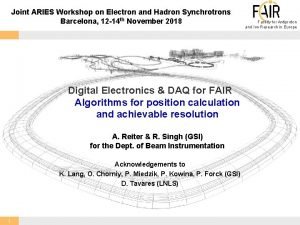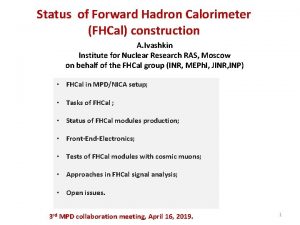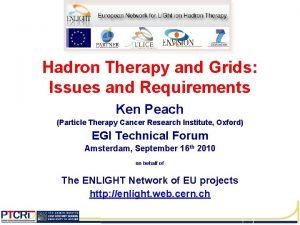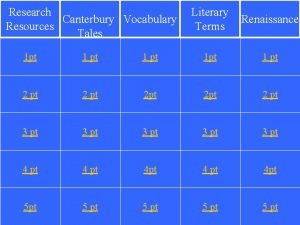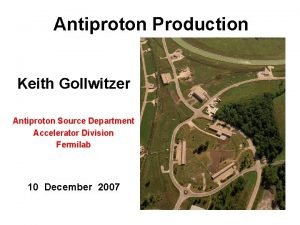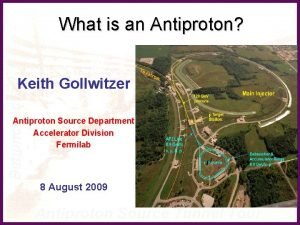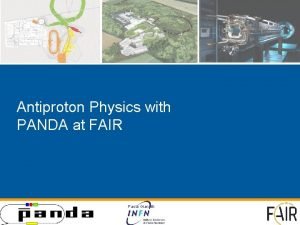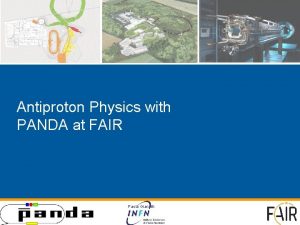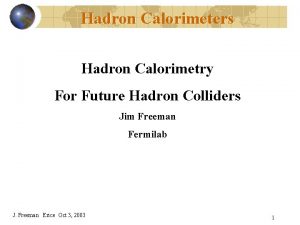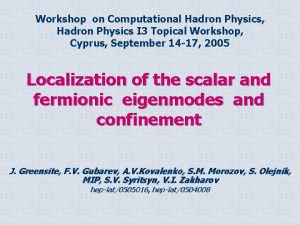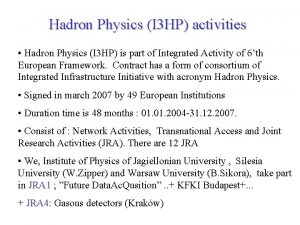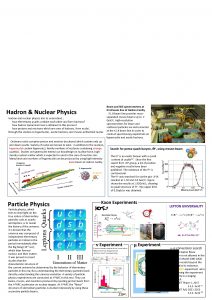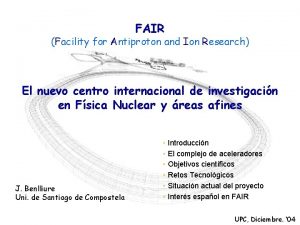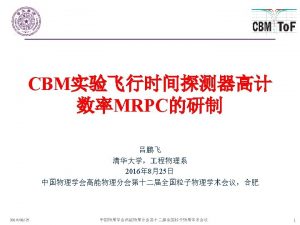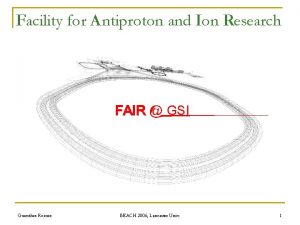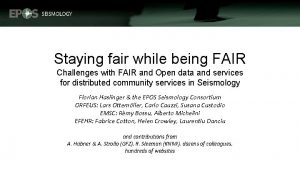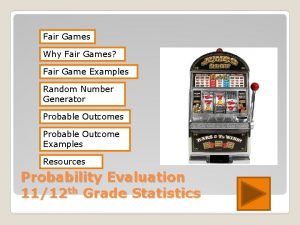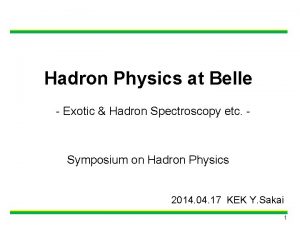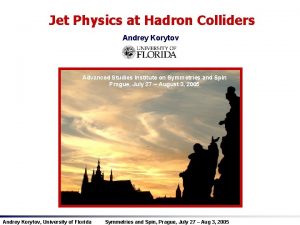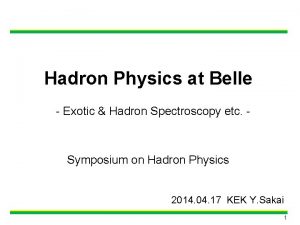Hadron Physics The FAIR Antiproton Program Hadron Physics








![PANDA playground p Momentum [Ge. V/c] 0 ● Meson spectroscopy − light mesons 2 PANDA playground p Momentum [Ge. V/c] 0 ● Meson spectroscopy − light mesons 2](https://slidetodoc.com/presentation_image/8c79e4f59b7cba5dd484bbfae67c5c2b/image-9.jpg)















































- Slides: 56

· Hadron Physics · The FAIR Antiproton Program

Hadron Physics At the energy scale of the nucleus, our understanding of the structure of the baryons and mesons, is still incomplete. • We have to deal with strongly interacting many-body systems (hadrons) whose mass is largely determined by their relativistic quarkgluon dynamics. • The current quark masses account for only 2% of the mass of a hadron. • We cannot separate out the constituents of hadrons – there are no free quarks in nature. They are confined in hadrons and we do not yet have a theory that explains this properly.

Theoretical Framework p p p Potential models bound systems of heavy quarks can be treated in the framework of nonrelativistic potential models, reproducing the asymptotic behaviour of QCD. Masses and widths are obtained by solving Schrödinger’s equation. Lattice QCD (LQCD) n The QCD equations of motions are discretized on a 4 -dimensional space-time lattice and solved numerically by computer calculations. n Enormous progress in recent years (e. g. gradual transition from quenched to unquenched calculations). n Ever increasing precision, thanks also to synergies with EFT. Effective Field Theories (EFT) They exploit the symmetries of QCD and the existence of hierarchies of scales to provide effective lagrangians that are equivalent to QCD for the problem at hand. n With quark and gluon degrees of freedom (e. g. Non Relativistic QCD or NRQCD) n With hadronic degrees of freedom (e. g. Chiral Perturbation Theory).

Theoretical Framework The second approach, Effective Field Theories, creates phenomenological models that are simpler to deal with, but keep resemblance to the real things. Cross-sections and branching fractions can be predicted. m 2π0 K 0 [Ge. V]2 The first approach, Lattice QCD, solves the equations numerically. That’s not easy. Fortunately, powerful modern computers have made it possible to calculate a few of the key predictions of QCD directly. m 2π+K 0 [Ge. V]2 Science 322 (2008) 1224 [ar. Xiv: 0906. 3599 [hep-lat]]. The agreement with the measured masses is at the few% level. Dalitz plot and decay width for the channel K ∗+� π+K 0π0 EPJA 39: 205, 2009 ar. Xiv: 0807. 4686 [hep-ph]

Experimental Techniques e+e− collisions + low hadronic background + high discovery potential − direct formation limited to vector states − limited mass and width resolution for non vector states direct formation two-photon production initial state radiation (ISR) B meson decay (Ba. Bar, Belle, BES, CLEO(-c), LEP, Belle II, . . . ) pp annihiliation (LEAR, Fermilab E 760/E 835, PANDA) − high hadronic background + high discovery potential + direct formation for all (nonexotic) states + excellent mass and width resolution for all states Hadroproduction Electro- and Photo- production (CDF, D 0, LHC) (HERA, JLAB)

The FAIR Facility Antiproton production Linac: 50 Me. V protons SIS 18: 5∙ 1012 protons / cycle SIS 100: 2 -2. 5∙ 1013 protons / cycle Production target: 29 Ge. V protons bunch compressed to 50 nsec 2∙ 107/s (7∙ 1010/h) antiprotons Primary Beams • 238 U 28+ 1. 5 Ge. V/u; 1012/s ions/pulse • 30 Ge. V protons; 2. 5 x 1013/s • 238 U 73+ up to 25 (- 35) Ge. V/u 1010/s p-Linac SIS 18 SIS 100/300 UNIL AC Secondary Beams • Broad range of radioactive beams up to 1. 5 - 2 Ge. V/u • Antiprotons 3 (0) - 30 Ge. V Rare-Isotope Production Target HESR Anti-Proton Production Target CR & RESR Cryring NESR 100 m

HESR - High Energy Antiproton ring For commissioning protons can be injected from: • RESR at reversed field polarities • SIS 18 at 12. 7 Tm with same field polarity, but opposite direction Experiment Mode Target Internal Target H 2 (ρ=0. 08 g/cm 2) p d = 1 mm Momentum range Luminosity rms-momentum resolution High Luminosity Mode Cluster-jet/ Pellet Target thickness 4∙ 1015 cm-2 rms-emittance Intensity from RESR High Resolution Mode 1 mm mrad 1. 5 – 8. 9 Ge. V/c 1. 5 – 15. 0 Ge. V/c 1∙ 1010 p 1∙ 1011 p 2∙ 1031 cm-2 s-1 2∙ 1032 cm-2 s-1 10 -5 10 -4 The p -beam is injected from RESR at 3. 8 Ge. V/c

HESR - Prototyping & Tests at COSY WASA Barrier Bucket Cavity Stochastic Cooling Residual Gas Profile Monitor 2 Me. V e-Cooler
![PANDA playground p Momentum Ge Vc 0 Meson spectroscopy light mesons 2 PANDA playground p Momentum [Ge. V/c] 0 ● Meson spectroscopy − light mesons 2](https://slidetodoc.com/presentation_image/8c79e4f59b7cba5dd484bbfae67c5c2b/image-9.jpg)
PANDA playground p Momentum [Ge. V/c] 0 ● Meson spectroscopy − light mesons 2 4 ΛΛ ΣΣ ΞΞ − charmonium − exotic states üglueballs ü hybrids ümolecules/multiquarks − open charm ΩΩ 6 8 DD Ds. Ds qqqq nng, ssg • e. m. processes ΩcΩc ccg nng, ssg ccg ggg, gg ● Charm in nuclei − Hyperatoms − S = -2 nuclear system ü Ξ− nuclei ü ΛΛ hyepernuclei ΛcΛc ΣcΣc ΞcΞc ccqq ● Baryon/antibaryon production ● Strangeness physics 10 12 15 ggg light qq π, ρ, ω, f 2, K, K* 1 2 cc J/ψ, ηc, χc. J 3 4 5 6 Mass [Ge. V/c 2]

Charmonium spectroscopy charmonium is a non relativistic bound system: c v r c The system is non relativistic: The mass scale is perturbative: The structure of separated energy scales makes charmonium an ideal probe of (de)confinement. Charmonium probe the perturbative, non-perturbative and transition regimes.

Charmonium spectroscopy All 8 states below open charm threshold are well established experimentally, although some precision measurements still needed (e. g. c(2 S), hc) The region above threshold still to be understood: - find missing states (e. g. D-wave) - understand nature of newly discovered states (e. g. X Y Z) Hyperfine splitting of charmonium states gives access to VSS component of quark potential model

ηc(2 S) Belle PDG 2012 M( c ) = 3638. 9 1. 3 Me. V/c 2 Γ( c) = 10 4 Me. V Mhf(2 S)cc M( (2 S)) - M( c(2 S)) = 47. 2 1. 3 Me. V

Chengping Shen – PIC 2013

Mesons Without entering into the details of each state some general consideration can be drawn. • masses are barely known; • often widths are just upper limits; • few final states have been studied; • statistics are poor; • quantum number assignment is possible for few states; • some resonances need confirmation… There are problems of compatibility Theory - Experiment Arxiv: 09010. 3409 v 2 [hep-th]

Open. Charm states For the states c(u/d) theory and experiment were in agreement. DSJ(3040) The quark model describes the spectrum of heavy-light systems and it was expected to be able to predict unobserved excited DS(cs) mesons with good accuracy DS(2860) DS(2710) DS DS 1 2 DS(2460) The discovery of the new DSJ states has brought into question potential models Nowadays, there is a problem to reconcile Theory and Experimental results DS(2317) D*S DS

Charmonium spectroscopy e+e- → ’ → c 1, 2 → J/ → e+e- p p→ c 1, 2 → J/ → e+e- · e+e- interactions: - All states directly formed (very good mass resolution) cc 1 3500 Br(pp → c) = 1. 2 10 -3 1000 E 835 ev. /pb · pp reactions: CBall E 835 100 CBall ev. /2 Me. V - Only 1 -- states are formed - Other states only by secondary decays (moderate mass resolution) 3510 3520 Me. V Br(e+e- → ) ·Br( → c) = 2. 5 10 -5 ECM

Charmonium spectroscopy The cross section for the process: pp→cc→final state is given by the Breit-Wigner formula: The production rate is a convolution of the BW cross section and the beam energy distribution function f(E, E): The resonance mass MR, total width R and product of branching ratios into the initial and final state Bin. Bout can be extracted by measuring the formation rate for that resonance as a function of the cm energy E.

What PANDA can do for charmonium physics? p p States below DD threshold n The study of the hc remains of very high priority. The width can be determined precisely with an energy scan of the resonance n The study of the c is just started. Small splitting from the have to be understood. Width and decay modes must be measured. The energy region above open charm threshold is the most interesting for the future and will have to be explored in great detail: n find all missing states, measure their properties. n explain nature of existing states (X(3872), Y(3940). . . ) n study radiative and strong decays, e. g. (4040) D*D* and (4160) D*D* , multi amplitude modes which can test the mechanisms of the open-charm decay.

What PANDA can do for charmonium physics? p At 2 1032 cm-2 s-1 accumulate 8 pb-1/day (assuming 50 % overall efficiency) 104 107 (cc) states/day. p Total integrated luminosity 1. 5 fb-1/year (at 2 1032 cm-2 s-1, assuming 6 months/year data taking). p Improvements with respect to Fermilab E 760/E 835: n Up to ten times higher instantaneous luminosity. n Better beam momentum resolution p/p = 10 -5 (FAIR) vs 2 10 -4 (FNAL) n Better detector (higher angular coverage, magnetic field, ability to detect hadronic decay modes).

Charmonium states width Thanks to the precise HESR momentum definition, widths of known states can be precisely measured with an energy scan. Energy scan of 10 values around the hc mass, width upper limit is 1 Me. V; each point represents a 5 day data taking in high luminosity mode, module 5 available, for the channel: hc�η cγ � g� 4 Kg with a S/B 8: 1 This holds for all known states in the charmonium region dp/p 10 -4 � G 100 Ke. V dp/p 10 -5 � G 10 Ke. V Sensitivity Γ R, MC[Me. V] Γ R, reco[Me. V] ΔΓR[Me. V ] 1 0. 92 0. 24 0. 75 0. 72 0. 18 0. 52 0. 14

The X(3872) state A charmonium(-like) state found by Belle in e+ e− X(3872) → J/ψ π+π− e. X Observation of decay into J/ψγ and Ψ’γ * → C=+1 Mass of X(3872) → D 0 D*0 shifted by ~3 Me. V/c 2 → S-wave molecular state? e+ J/ψ π π Width is unknown upper limit Γ < 2. 3 Me. V/c 2 (Belle) New helicity amplitude analysis from LHCb → JPC = 1++ p p c 0++, 1++ 2++ (L=0) 2 gluons: 0−+, 2−+ (L=1) c p c −− +− 3 gluons: 1 , 1 p c Quantum numbers can be determined by studying angular distributions

X(3872) J/ψ π+π- simulation 4 -particle invariant mass Formation Efficiency: 72% J/ψ p p RMS: 8. 3 Me. V/c 2 X(3872) π π X Either neutral and charged pions! It is interesting to check breaks isospin in the decays J/ (-> + −), J/ (-> + − 0) → is it charmonium? 3872 Me. V/c 2 Simulation at Ös = pbeam=6. 99100 Ge. V/c Baseline assumption: peak = 50 nb J/ψ → e+e- or μ+μ- Selection of inv. J/ψ-mass Combination with π+π- with PID S/B: 2

Measurement of X(3872) width m = 3872. 01 ± 0. 03 Me. V/c 2 Γ = 1. 11 ± 0. 08 Me. V/c 2 → Unfolding beam profile ( p/p = 3 · 10 -5) Mass resolution ~ 50 ke. V/c 2 Width precision ~ 10% each data point 2 days data taking 10 steps a 400 ke. V/c 2 3870. 2 – 3873. 8 Me. V/c 2 p/p = 3 · 10 -5

Heavy-light Ds. J systems Up to now the widths of the new discovered Ds. J state are only constrained by upper limits of few Me. V due to detector resolution. the p momentum spread in the HESR is sufficiently small to allow the measurement of the Ds. J widths in a threshold scan of the reaction pp → Ds Ds. J Fit of the excitation function obtained from the reconstructed signal events

Exotic hadrons In the light meson region, about 10 states have been classified as “Exotics”. Almost all of them have been seen in pp… OBELIX A. Bertin et al. , Physics Letters B 361, (1995), 187. A. Bertin et al. , Physics Letters B 385, (1996), 493. A. Bertin et al. , Physics Letters B 400, (1997), 226. F. Nichitiu et al. , Physics Letters B 545, (2002), 261. Crystal Barrel

Spectroscopy with antiprotons Two are the mechanisms to access particular final states: p Production p G _ p H _ p M M all JPC available Even exotic quantum numbers can be reached σ ~100 pb Exotic states are produced with rates similar to qq conventional systems All ordinary quantum numbers can be reached σ ~1 μb Formation _ only selected JPC p p G _ p H

Glueballs p Light gg/ggg-systems are complicated to be identified p Oddballs: exotic heavy glueballs n m(0+-) = 4740(50)(200) Me. V n m(2+-) = 4340(70)(230) Me. V p Glueballs decays most favourable to PANDA are: n ΦΦ or Φη if mass < 3. 6 Ge. V/c 2 n J/ψη or J/ψΦ if mass > 3. 6 Ge. V/c 2 n heavy oddballs (4 -5 Ge. V/c 2) DD*η/π0, p Same run period as hybrids Morningstar und Peardon, PRD 60 (1999) 034509

pp f 2(2000 -2500) The primary goal of this study is to test our capability of reconstructing final states which are expected to be good for exotics (glueball) searching. This is the region where the BES experiment found an evidence for a tensor (JPC = 2++) glueball candidate (2230). The detection of a possible resonant signal require an energy scan around the central energy value in order to measure the dynamic behavior of the cross-section. The analysis consists in 3 steps: • reconstruction of the signal; • evaluation of the background level; • simulation of the energy scan. We generated 50 • 103 signal events and 106 bck events. 4 C fit: efficiency 25%

f 2(2235) energy scan We made the assumption of a mass value of 2235 Me. V/c 2 and a widths of 15 Me. V/c 2 Fit of the total cross section and the derived signal cross-section For a scan width of 10 nb Needed beam time to achieve a 10 significance

QCD dynamics In the quark picture hyperon pair production either involves the creation of a quark-antiquark pair or the knock out of such pairs out of the nucleon sea. Hence, the iimportance of quark degrees of freedom with respect to the hadronic ones can be studied by measuring the reactions of the type pp →YY

QCD dynamics The experimental data set available is far from being complete. All strange hyperons and single charmed hyperons are energetically accessible in pp collisions at PANDA. In PANDA pp ΛΛ, ΛΞ, ΞΞ , ΣΣ, ΩΩ, ΛcΛc, ΣcΣc, ΩcΩc can be produced allowing the study of the dependences on spin observables. By comparing several reactions involving different quark flavours the OZI rule and its possible violation, can be tested

Double Strange Systems (DDS) 3 different systems containing double strangeness (S=-2) n Ξ- hypernuclei: Interaction: Ξ-N p - p n From Ξ-hypernucleus to ΛΛ hypernucleus: Ξ-N-ΛΛ coupling n Λ p n Double Λ-hypernuclei: Interactions: Λ-Λ e- n p p n Exotic hyperatoms: Interactions: Ξ--nucleus: interplay between the Coulomb and nuclear potential -

DSS production in PANDA 1 T a r g e t p N �bar +N Kbar+ Kbar +p + … [ �- production tag] K K Pbar +N - + bar : = 2 b; pbar (3 Ge. V/c) below production Elastic scattering in nucleus: strong slowing down (a challenge) slowing down in matter (with decay) Me. V �- capture into atomic levels and hyperatomic cascade Capture into nucleus: Strong and Coulomb forces 2 T a r g e t �- N �� conversion + �� sticking Xray N �� decay (MWD, NMWD… )

Ξ− rates & target sizes vs bunch contents Remarks: • target sizes can be very small • thickness of 3 μm is under test • mechanical and thermal properties to be evaluated Wth ·Ww [μm 2] (for different pbar production, satisfying background constraints) Stopped -/day(x 100) 2 x 107/s 1. 5 x 107/s 1 x 107/s Result: 1400 ÷ 2700 stopped At J-PARC 5800 are expected -/day expected

Nucleon structure In 50 years of activity e. N scattering experiments succeeded in describing Nucleon structure

Nucleon form factor The simplest structure function the Nucleon form-factor was considered well understood with the Rosenbluth approach (1γ exch. ) p e+ e- * p time-like q 2 >0 space-like q 2 <0 Most experiments could not determine |GM| and |GE| separately from the analysis of the angular distributions, but extracted |GM| using the (arbitrary) assumption |GE| = |GM|.

Nucleon ff in the space-like region Data on the ratio GE/GM for the proton including the older Rosenbluth separation data (crosses), most recent JLab Rosenbluth separation data (filled circles), and polarization transfer data (triangles) New Jlab data have been obtained with the recoil polarization method stating that: PRL 94 142301 (2005) The old assumption seems no more valid

Nucleon ff in the time-like region p p p |GE| and |GM| in the Time-Like region can be determined by the reactions pp ↔ e+e. Presently statistics is limited no real separation |GE|/ |GM| extracted assuming |GE| = |GM| (true at threshold) GE in Time-Like region is today unknown Recent data from Ba. Bar extraction of the ratio R = |GE|/ |GM| through the ISR method (e+e- gpp) (q 2<7 (Ge. V/c)2)

PANDA plans for the ff p p Separate measurement of |GE| et |GM| Precisions on the ratio R=|GE|/|GM| and s. R n DR/R <1% at low Q 2 n DR/R = 10% at Q 2=10 (Ge. V/c)2 n Separation possible up to Q 2=15 (Ge. V/c)2 Test of the 1 g hypothesis (symmetry of the angular distribution) Measure |GM| up to Q 2=25 (Ge. V/c)2

PANDA plans for the ff ~100 days, L = 2. 1032 cm-2 s-1 ds/d. W [ |GM(q 2)|2(1+cos 2 )+4 m. N 2/q 2 |GE(q 2)|2 sin 2 )] +e+-e-pp→e Nb Nbof ofcountsfor forpp→e + e. Nb of counts for pp→e en 10 7 s 10 B. Ramstein J. Van de Wiele 5 6 104 counts 106 counts 3000 counts 80 counts Q²=22. 3 (Ge. V/c)² R=|GE|/|GM| cos cm) cos( Elab=1 Ge. V Elab=2. 5 Ge. V Elab=10 Ge. V s=q 2=5. 4 (Ge. V/c)2 q 2= 8. 2 (Ge. V/c)2 q 2=12. 9 (Ge. V/c)2 q 2=22. 3 (Ge. V/c)2 6 09/03/2007 B. Ramstein N =10 tot DR=0. 6% Ntot=66000 EM working group Ntot=2750 DR=3% DR=25% Ntot=82 DR= 100% 40

Generalized Parton Distributions perturbative QCD γ* γ Wide angle Compton scattering factorisation into hard amplitude (calculable in perturbative QCD) and soft amplitude (information on parton distributions) H, E(x, ξ, t) ~ ~ H, E(x, ξ, t) Ide nti ca rev l diag ers r ed am non-perturbative QCD Reversed Deeply Virtual Compton Scattering pp γγ clear experimental signature both baryons in ground state σ ≈ 2. 5 pb @ s ≈10 Ge. V 2 L = 2· 1032 cm-2 s-1→ 103 events per month

Transversity In the QCD description of the partonic structure of the nucleon last leading-twist missing piece is transversity q(x, Q 2) unpolarized quark distribution Δq(x, Q 2) helicity distribution h 1 q(x, Q 2) transversity distribution In deep-inelastic lepton scattering transversity distribution folded with fragmentation functions transversity distribution directly accessible via the double transverse spin asymmetry (ATT) in Drell-Yan production of lepton pairs

PANDA Collaboration • At present a group of 500 physicists from 64 institutions and 17 countries Austria – Belaruz – China – France – Germany – India – Italy – The Netherlands – Poland – Romania – Russia – Spain – Sweden – Switzerland – Thailand - U. K. – U. S. A. AMU Aligarh, Basel, Beijing, BITS Pillani, Bochum, IIT Bombay, Bonn, Brescia, IFIN Bucharest, IIT Chicago, AGH-UST Cracow, JGU Cracow, IFJ PAN Cracow, Cracow UT, Edinburgh, Erlangen, FAIR, Ferrara, Frankfurt, Gauhati, Genova, Giessen, Glasgow, BIT Goa, GSI, FZ Jülich, JINR Dubna, Katowice, KVI Groningen, Lanzhou, LNL, LNF, Lund, Mainz, Minsk, ITEP Moscow, MPEI Moscow, TU München, Münster, BARC Mumbai, Northwestern, BINP Novosibirsk, IPN Orsay, Pavia, IHEP Protvino, PNPI St. Petersburg, South Gujarat Univ, SVNIT Surat, Sadar Patel Univ, KTH Stockholm, FH Südwestfalen, Suranaree Uo. T, Dep. A. Avogadro Torino, Dep. Fis. Sperimentale Torino, Torino Politecnico, Trieste, TSL Uppsala, Tübingen, Uppsala, Valencia, NCBJ Warsaw, TU Warsaw, AAS Wien http: //www-panda. gsi. de/ Spokesperson: Jim Ritman (FZ Jülich)

General Purpose Detector requirements: • nearly 4 solid angle (partial wave analysis) • high rate capability (2· 107 annihilations/s) • good PID ( , e, , , K, p) • momentum resolution (~1%) • vertex info for D, K 0 S, L (c = 317 m for D±) • efficient trigger (e, , K, D, L) • modular design (Hypernuclei experiments)

Pellet or cluster-jet target 2 T Superconducting solenoid for high pt particles 2 Tm Dipole forward tracks

Target system N 2 Requirements – Proton Target – 5 x 1015 cm-2 for maximum luminosity • Pellet Target – Frozen droplets 20 m – also possible: D 2, Ne, . . . – Status: 5 x 1015 • Cluster Jet Target – Dense gas jet – also D 2, Ne, . . . – Status: 8 x 1014 areal density [a. u. ] • -20 H 2 Cluster beam after nozzle 0 -10 10 transverse position[mm] 20

Central Tracker Silicon Microvertex detector Forward Chambers 47

Silicon Micro Vertex Detector • • • 4 barrels and 6 disks Inner layers: hybrid pixels (100 x 100 µm 2) – 140 module, 12 M channels Outer layers: silicon strip detectors – double sided strips – 400 modules, 200 k channels Mixed forward disks Continuous readout Requirements • c (D±) 312 m c (Ds±) 147 m • Vertex resolution 50 m 48

Central STT Layout § 4636 Straw tubes in 2 semi-barrels around beam/target cross 4636 Straw tubes pipe § 23 -27 planar layers in 6 hexagonal sectors 23 -27 planar layers § 15 -19 axial layers (green) in beam direction § 4 stereo double-layers for 3 D reconstr. , with ± 2. 89° skew angle (blue / red) § Time readout (isochrone radius) § Amplitude readout (energy loss) § srΦ ~ 150(100) µm , sz~ 3. 0(2. 0) mm (single hit) mm § E /E < 8% for /K identification % § p /p ~ 1 - 2% at B=2 Tesla /p ~ 1 - 2% § X/X 0 ~ 1. 2% ( ~ 1. 2% 2/3 tube wall + 1/3 gas) § § Rin/Rout: 150 / 418 mm Length: 1500 mm + 150 mm (RO upstream)

Muon Detectors Forward RICH Barrel DIRC Barrel TOF Endcap DIRC Forward TOF 50

PANDA PID Requirements • Particle identification essential tool • Momentum range 200 Me. V/c– 10 Ge. V/c • Different processes for PID needed PID Processes • Čerenkov radiation: p > 1 Ge. V Radiators: quartz, aerogel, C 4 F 10 • Energy loss: p < 1 Ge. V 10% accuracy with STT, • Time of flight: needs a start detector • Electromagnetic showers: EMC for e and γ Energy Loss in STT Forward To. F 51

DIRC PANDA DIRC • Lens focussing • shorter radiator beam • no water tank • compact pixel readout (CP-PMTs or APDs) Lens Focussing

PWO EMC Forward Shashlyk EMC Hadron Calorimeter 53

PANDA PWO Calorimeters • PWO is dense and fast • Increase light yield: – improved PWO II – operation at -25°C • Challenges: – temperature stable to 0. 1°C – control radiation damage – low noise electronics • Delivery of crystals started Forward Endcap • 4000 PWO crystals • High occupancy in center • LAAPD readout Barrel Calorimeter • 11000 PWO Crystals • LAAPD readout, 2 x 1 cm 2 • σ(E)/E 1. 5%/√E + const. 54

Muon Detector Outside the solenoid “Muon Filter”, 4 layers Muon Filter, outside solenoid 4 x (60 mm/Fe + 30 mm/MDT) Inside the solenoid Barrel: 12 layers inside the yoke + 1 bi-layer (“zero” bi-layer) in before iron Endcap: 5 layers + “zero” bi-layer before iron Barrel, inside solenoid 12 layers of MDT + “zero” bi-layer Endcap, inside solenoid 5 layers of MDT m beam direction Proportional tubes : anode signal and induction signal on 1 cm strips

Hypernuclear Detector beam Internal C target to produce Active silicon target to stop the and detect the hypenuclei decay products Germanium array detector, with 15 clusters of 3 gemanium Germanium array Forseen 2 Ke. V enery resolution, 1. 3 Me. V π energy resolution active target
 Low energy antiproton ring
Low energy antiproton ring Aries bpm
Aries bpm Hadron calorimeter
Hadron calorimeter Hadron collider
Hadron collider Hadron collider
Hadron collider Lhc tantalizing new physics
Lhc tantalizing new physics Hadron
Hadron Sonnet 14 shakespeare
Sonnet 14 shakespeare Foul is fair and fair is foul literary device
Foul is fair and fair is foul literary device Aside literary device
Aside literary device Who says fair is foul and foul is fair
Who says fair is foul and foul is fair Rhetorical devices syntax
Rhetorical devices syntax Play significa
Play significa Examples of fair is foul and foul is fair in macbeth
Examples of fair is foul and foul is fair in macbeth Hát kết hợp bộ gõ cơ thể
Hát kết hợp bộ gõ cơ thể Frameset trong html5
Frameset trong html5 Bổ thể
Bổ thể Tỉ lệ cơ thể trẻ em
Tỉ lệ cơ thể trẻ em Chó sói
Chó sói Tư thế worm breton là gì
Tư thế worm breton là gì Chúa yêu trần thế
Chúa yêu trần thế Các môn thể thao bắt đầu bằng tiếng đua
Các môn thể thao bắt đầu bằng tiếng đua Thế nào là hệ số cao nhất
Thế nào là hệ số cao nhất Các châu lục và đại dương trên thế giới
Các châu lục và đại dương trên thế giới Công thức tính độ biến thiên đông lượng
Công thức tính độ biến thiên đông lượng Trời xanh đây là của chúng ta thể thơ
Trời xanh đây là của chúng ta thể thơ Cách giải mật thư tọa độ
Cách giải mật thư tọa độ 101012 bằng
101012 bằng độ dài liên kết
độ dài liên kết Các châu lục và đại dương trên thế giới
Các châu lục và đại dương trên thế giới Thơ thất ngôn tứ tuyệt đường luật
Thơ thất ngôn tứ tuyệt đường luật Quá trình desamine hóa có thể tạo ra
Quá trình desamine hóa có thể tạo ra Một số thể thơ truyền thống
Một số thể thơ truyền thống Bàn tay mà dây bẩn
Bàn tay mà dây bẩn Vẽ hình chiếu vuông góc của vật thể sau
Vẽ hình chiếu vuông góc của vật thể sau Nguyên nhân của sự mỏi cơ sinh 8
Nguyên nhân của sự mỏi cơ sinh 8 đặc điểm cơ thể của người tối cổ
đặc điểm cơ thể của người tối cổ Thứ tự các dấu thăng giáng ở hóa biểu
Thứ tự các dấu thăng giáng ở hóa biểu Vẽ hình chiếu đứng bằng cạnh của vật thể
Vẽ hình chiếu đứng bằng cạnh của vật thể Phối cảnh
Phối cảnh Thẻ vin
Thẻ vin đại từ thay thế
đại từ thay thế điện thế nghỉ
điện thế nghỉ Tư thế ngồi viết
Tư thế ngồi viết Diễn thế sinh thái là
Diễn thế sinh thái là Dạng đột biến một nhiễm là
Dạng đột biến một nhiễm là Số.nguyên tố
Số.nguyên tố Tư thế ngồi viết
Tư thế ngồi viết Lời thề hippocrates
Lời thề hippocrates Thiếu nhi thế giới liên hoan
Thiếu nhi thế giới liên hoan ưu thế lai là gì
ưu thế lai là gì Hổ sinh sản vào mùa nào
Hổ sinh sản vào mùa nào Sự nuôi và dạy con của hươu
Sự nuôi và dạy con của hươu Sơ đồ cơ thể người
Sơ đồ cơ thể người Từ ngữ thể hiện lòng nhân hậu
Từ ngữ thể hiện lòng nhân hậu Thế nào là mạng điện lắp đặt kiểu nổi
Thế nào là mạng điện lắp đặt kiểu nổi Why does it happen
Why does it happen
